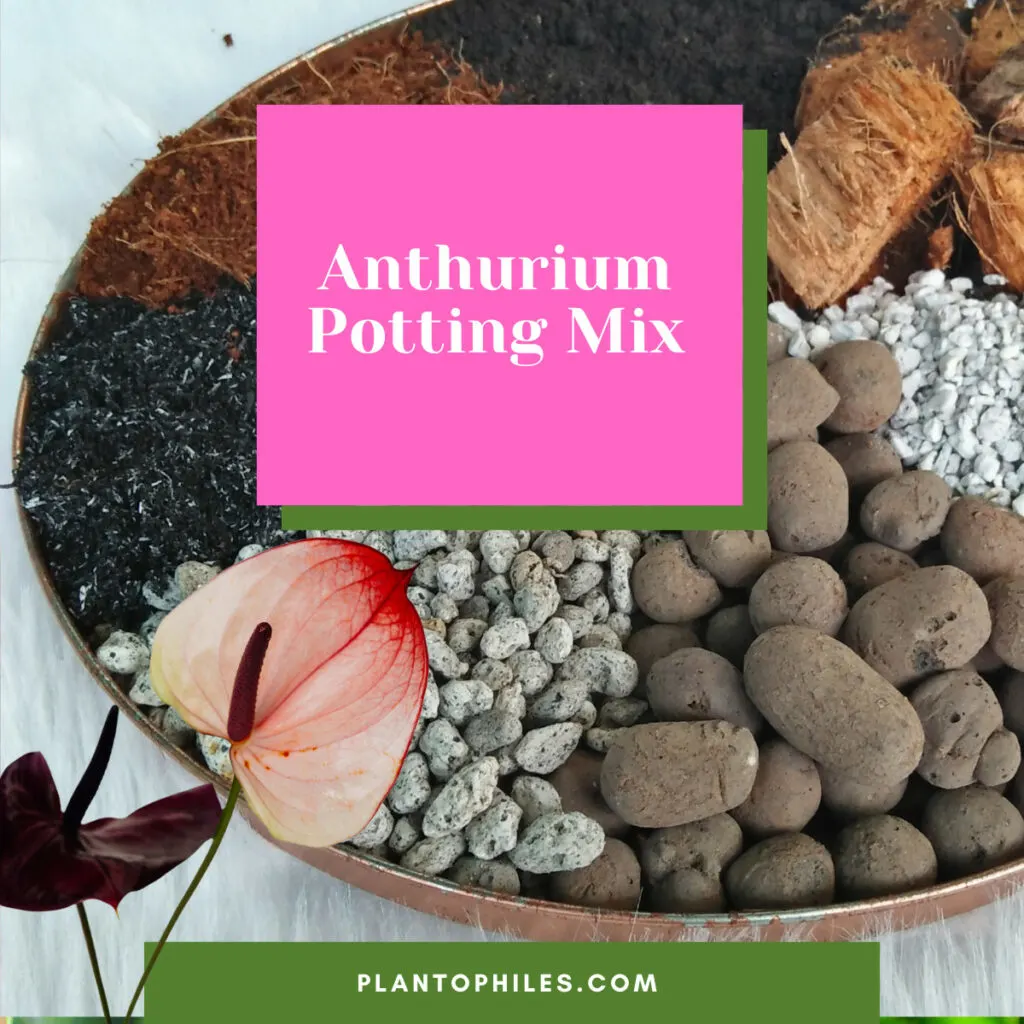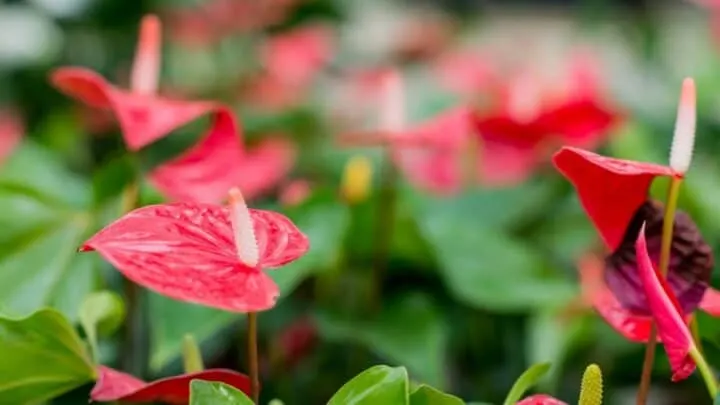I never realized how important the kind of potting soil is to grow Anthurium in, together with the type of pot it is planted in.
After learning from my mistakes, where my choice of standard garden soil led to my Flamingo flower (aka anthurium) dying due to root rot, I experimented and learned much more about these plants.
Anthurium can bloom all year long in the right growing conditions, including the right potting mix.
Stick around to learn what potting mix you can buy for your anthurium and why self-made potting soil is the best.
Table of Contents
Anthurium Potting Mix
The best potting mix for your anthurium is one that is a loose and coarse growing medium. While you can use a store-bought orchid potting mix, it’s better to improve the soil’s drainage quality by adding chunky ingredients like coconut husks, pumice, perlite, and charcoal. You can also create your own potting mix. Just ensure that the potting mix has a 5.5-6.5 pH.

The Best Potting Soil for Anthurium
Anthuriums are epiphytes, a kind of air plant. Most Anthurium is climbers, so their roots extend into leaf litter or moss that builds up under trees that they climb onto, or they grow aerial roots.
As such, Anthurium should not be planted in dense soil since its roots need oxygen. Dense soil contains fine particles that retain too much water.
And while all plants need water to thrive, if the soil an anthurium is planted in becomes waterlogged, then microbes can build up, and the roots can rot. This leads to your houseplant dying, which is something neither of us would want.
Thus, the best potting soil for Anthurium is a looser substrate with many large air pockets to emulate their native growing conditions in the tropics of Central and South America.
However, I never buy standard garden soil for my Flamingo flowers, and neither should you, as these soils don’t drain water fast enough and don’t provide enough air for the roots of an anthurium.
The best potting soil you can buy is an orchid potting mix, especially if you can get the kind specifically intended for Phalaenopsis orchids, which are also epiphytes.
These kinds of soil typically mix conifer bark, perlite, and peat moss, and these are ideal for water to drain well. They provide enough airiness in the soil for the anthurium’s roots to thrive.
Why Mix Your Own Potting Mix for an Anthurium
When I don’t have a lot of time, I buy orchid potting mix; however, I prefer to mix my own potting soil for my Anthurium.
The reasons include that a home-made blend:
- Provides better drainage as I ensure the soil is even coarser, so root rot is not something I need to worry about.
- Is more environmentally friendly. Peat moss, which is a standard ingredient in store-bought potting mixes, is a non-renewable resource. I prefer to use sustainable alternatives where possible.
Anthurium Potting Mix Ingredients
Here’s a list of the kinds of ingredients you can use to create your home blend of Anthurium potting mix. I’ll also share which options I use and why.
- Pumice: To add aeration and improve soil drainage, I generally add pumice to my potting mix for my Flamingo flowers.
- Hardwood charcoal: This is similar to perlite, but it is more sustainable, and thus why I prefer using this ingredient. It is also chunkier but lighter than perlite. A note of caution: don’t use the briquets you can buy for grilling your steaks at home!
- Perlite: If you can’t find hardwood charcoal, perlite is a good alternative. I prefer to buy mine in a super coarse grade to improve my anthurium’s soil drainage further and to add air.
- Compost: I like to add a little compost instead of synthesized fertilizers or peat moss to my potting mix. It enhances flowering and plant growth with the nutrition it provides. However, compost has denser particles, so I increase the coarseness of the other ingredients, hence, choosing a super coarse grade perlite. You can add more pumice and bark to your mix if you add compost.
- Coconut husk: While not as acidic, it is a fairly decent alternative to pine bark or fir.
- Cocopeat or coconut coir: A popular replacement for peat moss, coconut coir is made of dried, ground-up coconut shells. It is a fluffy growing medium that is loose enough and great for Anthurium and other epiphytes.
For my potting mix, I essentially need three categories of ingredients. I need coarse, woody materials.
Coconut husks or pine bark will do. Next, I need perlite or pumice, which makes up the porous ingredients of the potting mix.
Lastly, I need cocopeat, compost, or peat moss to be the organic element.
I usually use one ingredient of each category in equal parts to the others. So, my go-to potting mix is equal parts pine bark, hardwood charcoal, and cocopeat.
When I add compost, I do 30% pine bark, 30% hardwood charcoal, 20% cocopeat, and 20% compost.
How to Mix the Potting Soil
In a large container, so I have enough room to mix all the potting mix ingredients thoroughly, I add my pine bark, cocopeat, and hardwood charcoal (and sometimes compost).
If the layering method appeals to you, don’t. This actually increases the chances of root rot as your drainage isn’t improved.
All the finer ingredients will make their way in between the open areas of the coarser ingredients.
Moreover, there won’t be much soil in the bottom of your pot, so a pool of water will accumulate when you water your Anthurium, and this is a perfect environment for a fungal infection to take root.
Frequently Asked Questions about Anthurium Potting Mix
What soil is best for Anthurium?
The best soil for Anthurium is a potting mix or soil that is similar to the soil the plant is currently potted in. Anthurium needs soil that is light and loose and that has a pH of between 5.5 and 6.5.
Can I use a potting mix for my anthurium?
It’s acceptable to use potting mix for your anthurium. For the best results, you should plant your anthurium in a potting mix that is coarse in texture, so it drains water well. If you are buying your potting mix at the nursery, get an orchid mix and mix it with peat moss and coarse sand.
Conclusion Best Anthurium Potting Mix To Use
Anthurium needs a loose, coarse potting mix that is airy and provides adequate water drainage for the plant to thrive. If you use finer, more compact potting soil, root rot will set in, and your pretty house plant will die.

Daniel has been a plant enthusiast for over 20 years. He owns hundreds of houseplants and prepares for the chili growing seasons yearly with great anticipation. His favorite plants are plant species in the Araceae family, such as Monstera, Philodendron, and Anthurium. He also loves gardening and is growing hot peppers, tomatoes, and many more vegetables.


